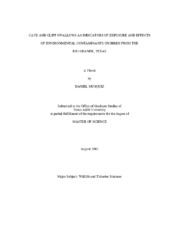Cave and cliff swallows as indicators of exposure and effects of environmental contaminants on birds from the Rio Grande, Texas
Abstract
Cave (Petrochelidon fulva) and cliff swallows (Petrochelidon pyrrhonota) were collected along the Rio Grande and evaluated as potential indicators of environmental contamination. The Rio Grande receives toxic substances from agricultural, industrial, municipal, and non-point sources; consequently, high levels of contaminants have been detected in birds, mammals, fishes and sediments. Swallows were obtained from 8 sites between Brownsville and El Paso, as well as from a reference site in Burleson County, 320 miles north of the nearest site of the Rio Grande. Blood samples were analyzed by flow cytometry, a technique that allows the detection of DNA damage in blood and other tissues. Plasma samples were analyzed for thyroid hormones using a radioimmunoassay technique. Organochlorines and trace metal analysis was limited to a few samples. DDE and PCB levels were below levels known to cause reduced hatching, embryo mortality, and deformities, Hg, Pb, and As were below detection, and Se, Ni and Cr concentrations were lower than levels known to cause harm in birds. Neither species showed sex-related differences in chromosome damage. Cave swallows from the Del Rio area had the highest levels of DNA variation, which may be indicative of DNA damage, possibly from PAHs exposure. Previous studies indicate that sediment samples from tributaries near Del Rio have high levels of chromium compared to other sites along the Rio Grande. A significant increase in DNA variation between sampling years was detected in cave swallows from Llano Grande Lake. Wildlife samples collected from Llano Grande Lake have recorded high levels of DDE and PCBs; in addition, this urban/agricultural contaminant sink appears to be affected by PAH exposure. T3 levels were below the detection limit of the radioimmunoassay. There were no gender related differences in T4 levels in cave swallows. Cave swallows sampled from Laredo had significantly higher T4 levels than those from birds at other sites during 1999. It was not possible to determine thyroid hormone disruption in plasma samples. Thyroid hormone and flow cytometry data were useful in establishing baseline data. Areas of concern based on genotoxic data include Llano Grande Lake, Del Rio, and El Paso.
Citation
Musquiz, Daniel (2003). Cave and cliff swallows as indicators of exposure and effects of environmental contaminants on birds from the Rio Grande, Texas. Master's thesis, Texas A&M University. Texas A&M University. Available electronically from https : / /hdl .handle .net /1969 .1 /1154.


